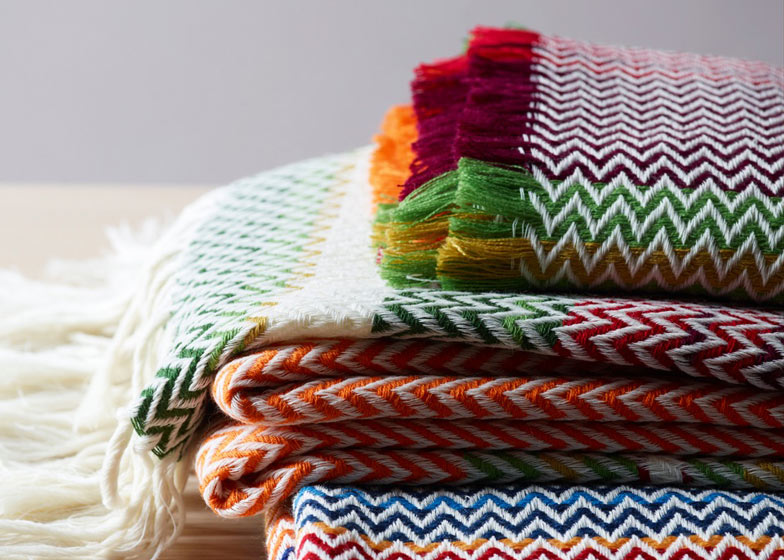Product news: Oslo designer Andreas Engesvik has created a series of blankets inspired by the textiles of Norwegian folk costumes.
Bunader are traditional costumes with roots in rural clothes from the eighteenth and nineteenth centuries and Andreas Engesvik worked with Norwegian manufacturer Mandal Veveri to make the wool Bunad Blankets.
They're based on motifs from five different regions in Norway: Setesdal, Nordland, Fusa, Bringeklut and Sunnmøre. "Mandal Veveri also had the complete recipes for all types of bunads, which made it easy for us to be exact," Engesvik told Dezeen.
"All the colours are exactly the same as on the bunads," he continued. "We did a lot of fine tuning of course, and we had to choose eight colours for every blanket, as this is the limit for the Jacquard machine."
"The bunad is one of the most visible and known traditions in Norwegian cultural heritage; the garment is a significant cultural carrier and is central to the passing on of Norwegian handicraft traditions," he added.
Andreas Engesvik is an alumni of the University of Bergen and the National College of Art and Design Norway. He was co-founder of Norway Says in 2000 and founded his own studio in Oslo in 2009. He has previously featured on Dezeen with his coloured screens in collaboration with Norwegian designer Daniel Rybakken.
For more cosy design, see our top ten rugs and blankets here or our Pinterest board on the topic here.
Here's some more information from the designer:
Bunad Blankets is a series of blankets launched during the London Design Festival, September 2012. The first Bunad Blankets we will show are based on bunad motifs from five different regions in Norway; Setesdal, Nordland, Fusa, Bringeklut from West Telemark, and mens bunad from Sunnmøre
The Idea for the Bunad Blanket came about one Christmas Eve a couple of years ago. I was sitting in the kitchen – surrounded by my girlfriend, her mother and her sister with husband. They were all wearing bunads from Setesdal. I sat in a chair while the others stood and walked around me. The abundance of colors, stripes and details where overwhelming. It hit me then, that bunads can be experienced as colors composed on a surface.
The Bunad Blanket is a new product category that encompasses recognizable aspects from the bunad tradition. Bunads are composed of color in proportion – that means compostition and disposition of surfaces. The bunad is further composed in a series of different materials and techniques such as embroidery, detail seam, pearls, wool, linen, metal and so on. The Bunad Blankets represents a simplification and transferring of the Norwegian folk costumes. The Bunad Blanket introduces this rich tradition into our daily environments and interiors.
The Bunad Blankets are developed in co-operation with Mandal Veveri and are woven from pure wool in Mandal. Mandal Veveri is a nearly 100 year old textile company, and has a young and ambitious leadership. It is the leading producer of textiles for bunads in Norway today. Mandal Veveri is owned by Stina Skeie.
The Bunad is a range of traditional Norwegian rural clothes and folk costumes with its roots dating from the 18th and 19th centuries. In Norway, it is common to wear bunad at various celebrations such as folk dances, weddings, and especially the May 17 National Day celebrations.
National romanticism still has a stronghold in Norway, and the bunad is one of the most visible and known traditions in Norwegian cultural heritage. It played a role in building national identity before and after 1905 – when Norway became independent. The bunad is a significant cultural carrier and is central to the passing on of Norwegian handicraft traditions. There are about 400 bunads and folk costumes in Norway today
The quality of the blankets has the right balance between weight and function (not too thick) and it drapes nicely. It is meant as an all-year blanket, to be used both at home and in the summer/winter cabin.
Designer: Andreas Engesvik
Junior designer: Ingrid Aspen
Company: Mandal Veveri, Stina Skeie
Material: wool
Dimensions: 130 x 200cm (without fringes)
Production: November 2012

